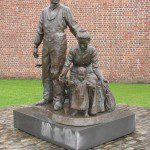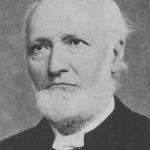
Jeff Bradshaw, one of the vice presidents of the Interpreter Foundation, and Russ Richins and James Jordan — respectively, the producer and associate producer of the Interpreter Foundation’s Witnesses film and our Undaunted: Witnesses of the Book of Mormon docudrama and our short “Witnesses” video features — are over in the Democratic Republic of the Congo at the moment, where they are gathering material for what we currently conceive as a series of short videos about the people and the history of the Church of Jesus Christ of Latter-day Saints in that distant land. There are some remarkable and inspiring stories from the Congo that are worthy both of preservation and of being known among the Saints at large, and I’m excited about the project. If you would like to help support this effort to its completion — the budget isn’t going to be vast, but some funds are still required — please join in and contribute. And please let us know that your donations are for the “Congo Project.”

These items have recently appeared on the website of the Interpreter Foundation:
This presentation was given by Stanford Carmack on 14 March 2015 at a small conference on “Exploring the Complexities in the English Language of the Book of Mormon”
The grammar of the Book of Mormon has been naively criticized since its publication in 1830. The supposedly bad grammar is a match with language found in the Early Modern English textual record. Syntactic usage, especially past tense with did and the command construction, points only to that era. Book of Mormon language exhibits well-formed variation typical of the 16th and 17th centuries.
As he regularly does, Jonn Claybaugh provides a concise set of helpful notes for students and teachers of the Church’s “Come, Follow Me” curriculum.
In the 23 April 2023 Come, Follow Me segment of the Interpreter Radio Show — which, having been edited to remove commercial breaks, is now being made available to you at no charge — Steve Densley, Mark Johnson, and John S. Thompson discuss New Testament lesson 21, “Behold, Thy King Cometh,” covering Matthew 21–23, Mark 11, Luke 19–20, and John 12.
The other segments of the April 23 radio show are accessible at https://interpreterfoundation.org/interpreter-radio-show-april-23-2023.
The Interpreter Radio Show can be heard Sunday evenings from 7 to 9 PM (MDT), on K-TALK, AM 1640, or you can listen live on the Internet at ktalkmedia.com.

The Book of Mormon, it seems, was originally written in a form of Egyptian by authors who also knew and spoke Hebrew (see 1 Nephi 1:2; Mormon 9:32–33). Some scholars have interpreted this to mean that the Nephite authors wrote in Egyptian, while others believe that they adapted an Egyptian script to write in Hebrew. In either case, this means that, notwithstanding the fact that the oldest currently available text of the Book of Mormon is the 1829 English translation, the original language of the book was ancient and Near Eastern.
Importantly, there are many other ancient texts that are also available only in translation, the original being long since lost. Sometimes, the translations date to times long after the originals were composed. A good example of this is the Apocalypse of Abraham , which was probably composed originally in either Hebrew or Aramaic sometime prior to AD 150 but which has only been preserved in Slavonic, in manuscripts dating to between the fourteenth and seventeenth centuries AD. Scholars have determined the likely original date-range and language of composition from “Hebraisms” or “Semiticisms” that have survived into the Slavonic.
Among other things, they have noted the frequent use of the Hebrew waw prefix, which is often translated as “and” or “but” in English. For example, Apocalypse of Abraham 11:4–5 reads:
And he said to me, Abraham. And I said, Here is your servant! And he said, Let my appearance not frighten you, nor my speech trouble your soul. Come with me! And I will go with you.”
Although repetitive to English speakers, this prefix was crucial in ancient Hebrew, which, because it lacked punctuation, needed some other way to distinguish between separate complete thoughts. Similarly, the phrase “and it came to pass” reflects a single word in Hebrew; it was commonly used as a temporal marker and is found prominently throughout the Apocalypse of Abraham.
Some quotations or allusions to the Bible found in the Apocalypse of Abraham appear to reflect the Hebrew Masoretic text (or the Aramaic Targums) rather than the Greek Septuagint. For instance, the expression “I said in my heart” (Apocalypse of Abraham 3:2) likely reflects the use of a Hebrew prepositional phrase that was not translated into the Targums or the Septuagint, making this a “true Hebraism.” Additional prepositional phrases invoke Hebrew syntax in ways not found in biblicized Greek, and body parts are sometimes used metaphorically in what seems a distinctively Hebrew fashion.
Moreover, some apparently Semitic words remain untranslated in the Slavonic text, seeming to point, therefore, to the text’s original language. An example of this occurs in Apocalypse of Abraham 1:8, when Terah requests that Abraham bring him his “axes and izmala,” the latter likely being a Hebrew word meaning “chisel.”
Perhaps most compelling, though, is the occurrence wordplays on names that would make sense only to a Hebrew- or Aramaic-speaking audience. For example, the name of the idol Barisat likely derives from the Hebrew/Aramaic name bar ’eshāth, meaning “son of fire” or “fiery one,” which is fittingly ironic since, in Apocalypse of Abraham 5, Barisat is destroyed by fire. Other idols bear Semitic names that either fit their narrative role or mock them.
It is such features that have persuaded most scholars that the Apocalypse of Abraham was originally written in a Semitic language, despite the fact that that original is lost.
Can a similar argument be made for the Book of Mormon?
Recent scholarship has argued that, very much like the Apocalypse of Abraham, the Book of Mormon contains linguistic features that are typical of ancient Near Eastern languages.
For instance, Donald W. Parry and other scholars have observed that the Book of Mormon often uses the waw prefix in a Hebrew-like way.
And I saw the heavens open, and the Lamb of God descending out of heaven; and he came down and showed himself unto them. And I also saw and bear record that the Holy Ghost fell upon twelve others; and they were ordained of God, and chosen” (1 Nephi 12:6–7).
Likewise, the Hebrew-like phrase “and it came to pass” is prominently used in the Book of Mormon, as is the use of body parts in the manner of the Apocalypse of Abraham.
Scholars have also pointed out seeming Hebraisms such as the use of the cognate accusative (e.g., “dreamed a dream”); the construct state (e.g., “works of righteousness” instead of “righteous works”); and compound prepositions (e.g., “by the mouth of angels” instead of “by angels”).
Could the many types and examples of Hebraisms in the Book of Mormon have been derived from the King James Bible? This seems problematic, not only because of the sheer number of them but because several Book of Mormon Hebraisms don’t appear in the King James Bible. For instance, Professor Parry observes that “sometimes in the Book of Mormon and is used where but is expected.” One example is found in Omni 1:25, which states that “there is nothing which is good save it comes from the Lord: and [or but] that which is evil cometh from the devil.” According to Parry, “such examples are indicative of a literal translation from a Hebrew-like text” since, in Hebrew, the waw prefix is used for both conjunctions, something that is lost in English translations of the Bible .
Another example of a common Hebrew construction is the if-and conditional clause. No examples of this occur in English translations of the Bible, but they do appear in the earliest manuscripts of the Book of Mormon. Thus, Mosiah 2:21 originally read: “I say if ye should serve him with your whole soul—and yet ye would be unprofitable servants.” “This finding,” says Parry, “underscores that the Book of Mormon’s use of Hebraistic literary forms cannot simply be attributed to Joseph Smith’s familiarity with the English Bible.”
In some cases, too, biblical quotations in the Book of Mormon reflect the Bible’s underlying Hebrew more closely than does the King James Version.
Like the Apocalypse of Abraham, the Book of Mormon contains untranslated words that appear to be of Semitic origin. For instance, the word sheum appears in a list of grains and crops in Mosiah 9:9 and is similar to “a common Akkadian word referring to cereal grains.” The word ziff appears in a list of metals (see Mosiah 11:3, 8) and may be derived from a Hebrew root meaning “splendor, brightness” (ziv), or it could be related to the place name Ziph found in Joshua 15:24 (cf. 1 Chronicles 2:42; 4:16).
Many Book of Mormon names have now been shown to have Semitic or Egyptian origins. Like other ancient texts, Book of Mormon names are used in wordplays that are lost in translation. For example, when Zeniff asks the Lamanite king if his people might “possess the land in peace,” the Lamanites give them “the land of Lehi-Nephi, and the land of Shilom” (Mosiah 9:5–6; emphasis added). The name Shilom is based on the Hebrew root sh-l-m, meaning “peace.” And Zeniff uses this root in an ironic twist: ultimately, there was war but no peace [ in the land of Shilom.
Many other examples could be given of proposed Hebraisms and seeming Semiticisms in the Book of Mormon, including specimens not readily derivable from English Bible translations of the Bible. In fact, the Book of Mormon has virtually all of the same features that have convinced scholars that the Slavonic Apocalypse of Abraham represents the translation of an ancient Semitic text. .
“It is highly doubtful,” observes Professor Parry, “that Joseph Smith knew anything about the Hebraic features of the Book of Mormon that have been identified by scholars long after his death.” Similarly, John Tvedtnes notes, “Many expressions used in the Book of Mormon are awkward or unexpected in English, even in Joseph Smith’s time. Yet they make good sense when viewed as translations, perhaps as too literal translations, from an ancient text written in a Hebrew-like language.”
For more extended treatment of this subject and references for further study, see “Why Are There Hebraisms in the Book of Mormon?” — from which this blog entry has been decocted (quite slavishly and without even a nod in the direction of originality) for my own nefarious purposes.













